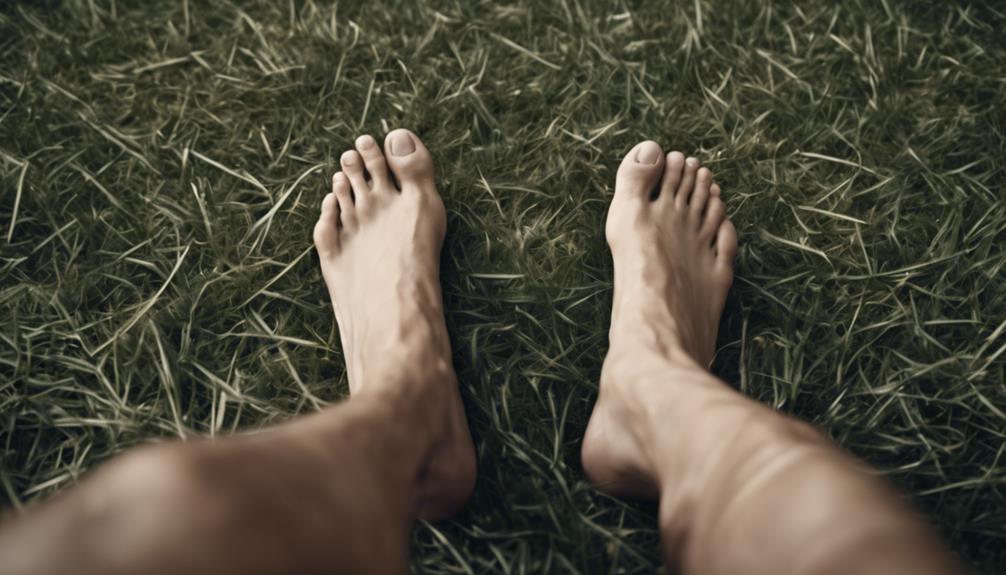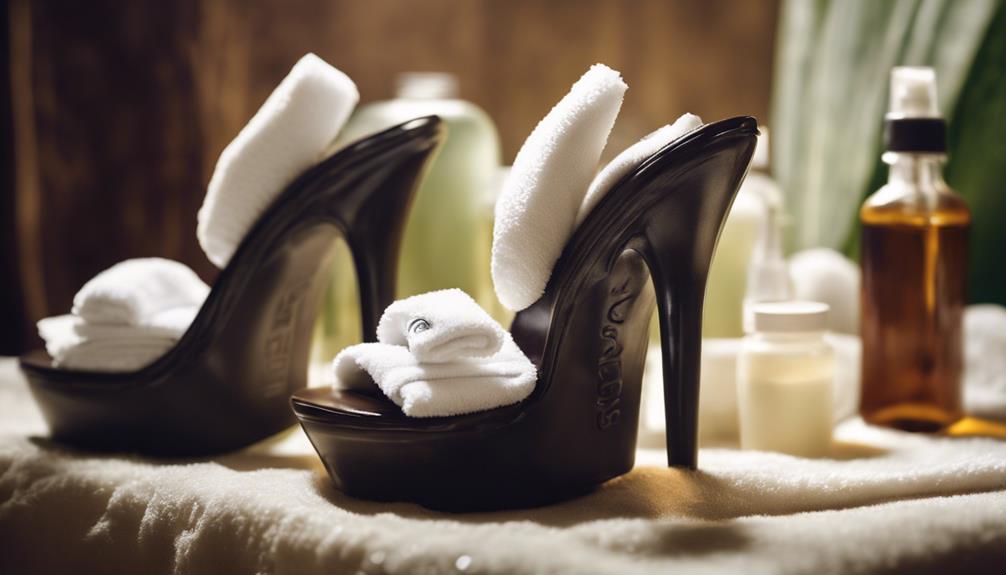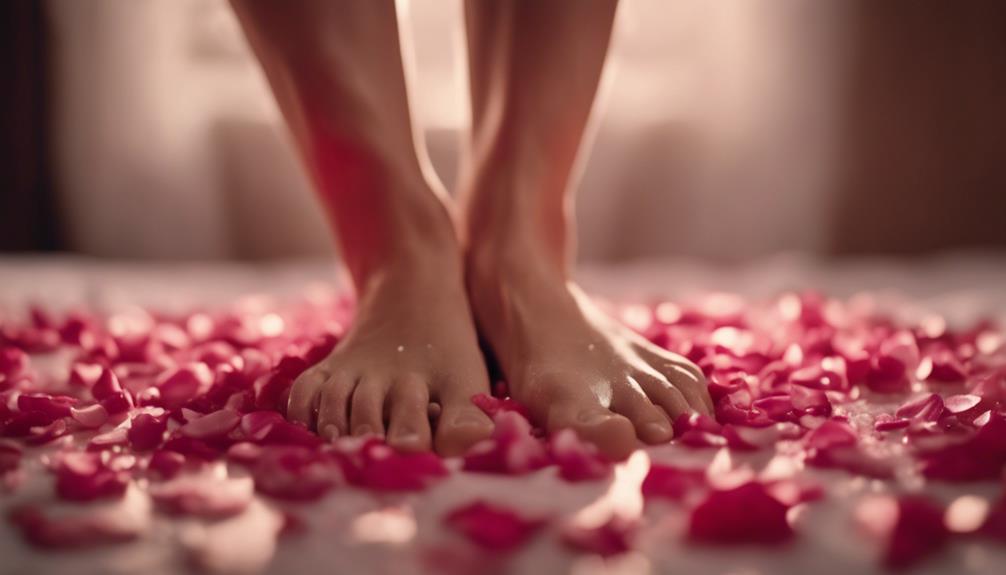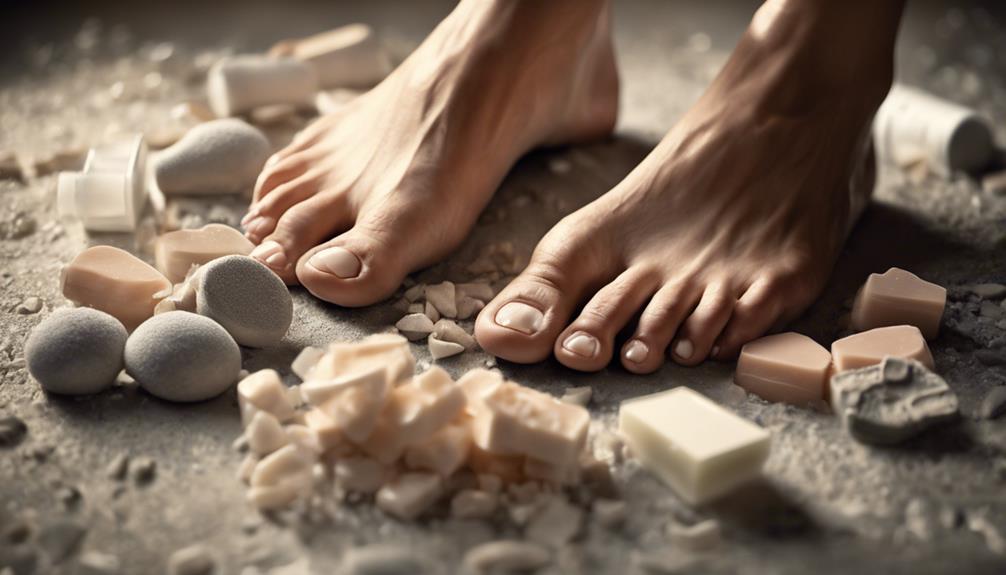I’ve learned the hard way that overlooking heel care is a step in the wrong direction. Neglect leads to pain, posture problems, and mobility issues. Think about it: our heels bear the brunt of our weight daily. Ignoring them can lead to plantar fasciitis and Achilles tendonitis, chronic conditions that sideline anyone. I incorporate stretching, moisturizing, and wearing the right shoes into my routine to prevent these troubles. Plus, exfoliation and proper nail care keep my heels healthy and looking good. Trust me, caring for my heels has made all the difference. And there’s more I’ve picked up along the way.
Key Takeaways
- Prevents conditions like plantar fasciitis and Achilles tendonitis, enhancing mobility and quality of life.
- Reduces the risk of chronic pain and mobility limitations from neglected heel health.
- Enhances foot mechanics and blood circulation, reducing inflammation and promoting healing.
- Supports proper weight distribution and posture, preventing back pain and joint issues.
- Prevents foot-related issues like bunions and Morton’s neuroma from improper footwear.
Understanding Heel Health

To sustain our overall well-being, it’s crucial to grasp the importance of heel health. Heel health isn’t just about avoiding discomfort; it’s vital for proper weight distribution and posture, which in turn, impacts our mobility and daily functioning. Common ailments like plantar fasciitis, heel spurs, and Achilles tendonitis can arise from neglecting our heels. These conditions can lead to chronic pain and limit our mobility, greatly affecting our quality of life.
I’ve discovered that regular stretching and strengthening exercises can greatly enhance heel health. These routines not only alleviate pain but also prevent future issues by enhancing flexibility and strength in the foot and ankle. Additionally, integrating proper footwear and orthotic inserts into our daily lives can provide extra support and protection for our heels. These interventions can be game-changers for those of us looking to maintain an active lifestyle without being hindered by heel pain.
Neglecting heel care isn’t worth the risk, considering the simple and innovative approaches available to safeguard our mobility and well-being. Embracing a routine that includes specific exercises and the right support can transform our heel health, allowing us to lead more active and fulfilling lives.
The Impact of High Heels
Despite their popularity, high heels often lead to numerous foot-related issues, including bunions and plantar fasciitis, due to the excessive pressure they place on the toes and heels. The allure of high heels is undeniable, yet the cost to our foot health can’t be ignored. Foot pain becomes a constant companion for many, a direct result of this pressure that disrupts our natural posture and alignment.
Regularly slipping into these stylish yet constricting shoes can cause our calf muscles to shorten, throwing off our gait and leading to a domino effect of discomfort. Our posture suffers, and soon, back pain and joint issues in the knees and hips become part of our daily battles. We can’t overlook the risk of developing Morton’s neuroma, a painful condition that affects the nerves in our feet, making every step a challenge.
To mitigate these risks, opting for lower heel heights or using heel cushions can offer some relief, preserving our foot health and comfort. It’s a small adjustment for a significant impact, ensuring that we can still enjoy the confidence boost high heels offer without compromising our well-being.
Daily Moisturizing Essentials

Incorporating daily moisturizing into my heel care routine prevents dryness and maintains my skin’s elasticity, ensuring my feet remain healthy and comfortable. I’ve learned that consistent moisturizing isn’t just about avoiding cracked heels; it’s a vital step in preserving the overall health of my feet. By keeping my heels hydrated, I greatly reduce the risk of developing painful heel fissures that can make every step a torment.
I’ve found that proper hydration of the heel area also wards off calluses and rough patches, which aren’t only unsightly but can lead to discomfort and further skin damage. Regular moisturizing keeps my skin supple, preventing the inflammation and irritation that often accompany dry, neglected feet.
Moreover, maintaining a daily moisturizing regimen is my first line of defense against infections. Hydrated skin is less prone to breaks and cracks where bacteria and fungi can enter, thereby promoting a healthy foot environment. I’ve embraced moisturizing as an essential part of my foot care routine, recognizing its role in ensuring my feet aren’t just aesthetically pleasing but are also in top health.
Proper Footwear Selection
In prioritizing heel care, I’ve learned that selecting the right shoes is essential. It’s not just about style; choosing appropriate heel height, material, and ensuring foot comfort can greatly alleviate heel pain.
This approach not only boosts my foot health but enhances my mobility and overall well-being.
Choosing Appropriate Heel Height
Choosing the proper heel height is crucial to minimize strain on my feet and lower limbs. I’ve discovered that appropriate footwear isn’t just about aesthetics; it’s a key element in preventing foot pain and discomfort.
Maneuvering through the day in heels that don’t meet the requirements can lead to dreaded conditions like plantar fasciitis and Achilles tendonitis. It’s not only about avoiding pain; the right heel height can greatly enhance my posture.
This realization motivated me to prioritize my health over fashion trends. By selecting heels that complement my body’s needs, I bypass potential foot problems, ensuring my steps aren’t only stylish but also secure and comfortable.
Material and Foot Comfort
While choosing the right heel height is a step in the right direction, I’ve learned that the material of the footwear plays an equally crucial role in ensuring my feet remain comfortable throughout the day. Opting for shoes that boast cushioning and arch support has been a game-changer in my quest to prevent heel discomfort.
I’ve discovered that materials like leather or memory foam not only provide superior heel support but also markedly reduce the risk of heel pain and injuries. This focus on material comfort has undeniably enhanced my overall foot health. It’s clear that prioritizing the quality and comfort of the material in my footwear is pivotal.
It’s not just about style; it’s about fostering lasting foot comfort and health.
Exfoliation and Dead Skin Removal

Exfoliating your heels regularly is essential for removing dead skin cells, preventing rough patches, and keeping your skin soft and smooth. As someone who’s always looking for innovative ways to enhance my skincare routine, I’ve found that focusing on heel care, particularly exfoliation, has been a game-changer. By shedding those dead layers, I’m not only preventing dryness but also promoting skin cell turnover which is vital for maintaining the health and appearance of my heels.
Here’s why you should consider making exfoliation a key part of your heel care routine:
- Prevents Cracks and Fissures: Regular removal of dead skin can significantly reduce the risk of developing painful cracks and fissures in your heels.
- Enhances Moisturizer Effectiveness: Exfoliated skin absorbs moisturizers better, ensuring your heels stay hydrated and protected against harsh environmental factors.
- Improves Overall Heel Health: By maintaining a regular exfoliation schedule, you’re not just working on the aesthetic aspect but are also taking important steps towards preventing conditions that could impair your mobility or cause discomfort.
Incorporating this simple step into my routine has made a noticeable difference in the way my heels look and feel, proving that a little attention to detail can lead to important improvements.
Nail Care and Hygiene
Shifting from exfoliation, it’s essential to emphasize the importance of nail care and hygiene in preventing foot problems. As someone passionate about innovative health routines, I’ve discovered that cutting your toenails isn’t just a matter of aesthetics; it’s a key step in a thorough heel care routine. Regular trimming and cleaning of nails can greatly prevent discomfort and pain, particularly from ingrown toenails and fungal infections.
Hygienic nail care doesn’t just stop at preventing these issues; it also promotes overall foot health. By maintaining clean and trimmed nails, you’re not just avoiding immediate discomfort; you’re also preventing the potential for bacterial growth and more severe foot issues down the line. It’s a simple yet effective strategy that underscores the importance of regular upkeep for long-term wellness.
Neglecting nail care might seem inconsequential at first, but it can lead to a host of problems that go beyond mere aesthetics. Incorporating regular trimming into your heel care routine is a proactive measure that safeguards not just your feet’s health but also your comfort and well-being. It’s a small but essential step in ensuring your feet remain in top condition, free from the risks of fungal infections and other discomforts.
Stretching Exercises for Feet

After covering nail care and hygiene, I’m turning my attention to the significance of stretching exercises for our feet.
I’ve found that incorporating these stretches into my daily routine not only boosts my foot flexibility but also plays a pivotal role in preventing heel discomfort.
Let’s explore how these exercises can benefit us, look at some daily techniques, and discuss ways to avert heel issues before they start.
Benefits of Foot Stretching
Incorporating foot stretching into my daily routine has greatly enhanced my flexibility, dramatically reducing the risk of painful injuries like plantar fasciitis. By stretching my feet regularly, I’ve noticed a significant improvement in my overall foot health. Here are three key benefits I’ve experienced:
- Improved Range of Motion: Stretching exercises for feet have boosted my foot mechanics, making walking and running smoother and more efficient.
- Increased Blood Circulation: This not only promotes healing but also helps reduce inflammation, providing relief from discomfort.
- Enhanced Flexibility: Regular foot stretching exercises have alleviated issues related to flat feet or high arches, making every step comfortable.
For anyone looking to innovate their self-care routine, prioritizing foot health through stretching is a game-changer.
Daily Stretching Techniques
To enhance foot health and prevent injuries, I’ve integrated daily stretching exercises into my routine, focusing on improving flexibility and reducing tension in my feet and ankles.
| Stretching Exercise | Benefit | Frequency |
|---|---|---|
| Toe Points | Improves flexibility, reduces risk of injuries | Daily |
| Ankle Circles | Relieves tension, enhances circulation | Twice daily |
| Towel Stretch | Promotes foot health, prevents pain and discomfort | Daily |
| Heel Raises | Benefits posture and balance, reduces tension | Daily |
These stretching exercises are not just routines; they’re innovative steps towards a healthier lifestyle. By dedicating a few minutes each day, I’m not only preventing future foot issues but also enhancing circulation and posture, proving that small changes can lead to significant benefits.
Preventing Heel Discomfort
Regularly stretching your feet can greatly reduce heel discomfort by enhancing flexibility and easing strain on the heel. As someone always on the lookout for innovative ways to improve my daily routine, I’ve discovered that integrating stretching exercises into my day not only wards off heel pain but also boosts my overall foot health. Here’s how:
- Plantar Fasciitis Prevention: Stretching helps alleviate symptoms of plantar fasciitis, a nagging source of heel discomfort.
- Calf and Achilles Tendon Relief: By focusing on stretching my calf muscles and Achilles tendon, I’ve notably reduced tension on my heel.
- Enhanced Blood Flow: Proper techniques in stretching increase blood flow, aiding in both relief and prevention of heel pain.
It’s a game-changer for anyone looking to stay active and pain-free.
Recognizing Common Heel Problems

Understanding common heel problems, such as plantar fasciitis and heel spurs, is vital for anyone experiencing foot discomfort. It’s a fact that heel pain affects 1 in 10 people at some point in their lives, making it a prevalent issue that demands innovative solutions. With millions annually impacted by plantar fasciitis alone, it’s clear that this isn’t just an occasional annoyance—it’s a widespread concern that can greatly impact one’s mobility and quality of life if ignored.
Heel spurs, bursitis, and Achilles tendonitis are also common culprits behind heel discomfort. These conditions aren’t just names in a medical textbook; they’re real issues that can sideline anyone from their daily activities. Ignoring heel pain is a risky gamble that can lead to chronic problems. That’s why it’s essential to not only recognize these conditions early but also to adopt proper heel care routines to prevent them from worsening.
For those of us seeking to stay ahead of the curve, understanding and addressing heel pain with innovative care strategies is key. It’s not just about reacting to pain—it’s about proactively managing our health to make sure our mobility and quality of life remain uncompromised.
Seeking Professional Foot Care
Seeking professional foot care from a podiatrist can proactively prevent serious complications and guarantee my feet stay healthy. By opting to visit a podiatrist regularly, I’m not just addressing current issues but also safeguarding my foot health against future problems. Podiatrists are at the forefront of diagnosing and treating a wide range of foot and ankle issues, ensuring that I get the most innovative and effective treatments available.
Here’s why I prioritize professional foot care:
- Tailored Treatment Plans: Podiatrists offer personalized care plans based on my unique needs, ensuring that I receive the most effective treatment.
- Preventive Care: Regular appointments help in preventing serious foot complications before they start, keeping my feet in top condition.
- Advanced Technologies: Podiatrists utilize the latest diagnostic and treatment technologies, offering cutting-edge solutions for foot and ankle problems.
Frequently Asked Questions
Why Is Routine Foot Care Important?
I’ve learned that staying consistent with my foot care routine is essential. It helps to prevent fungal infections and detects any foot issues early, ensuring that I’m always at ease and my posture is correct.
Moreover, when my feet appear healthy, I feel more self-assured. And, by scheduling regular appointments with a podiatrist, I’m avoiding severe complications.
It’s all about maintaining good health, feeling amazing, and looking my best from head to toe.
What Is the Reason Why Careful Foot Care Is Important?
I’ve realized that careful foot care is essential because it prevents a lot of common issues. By keeping up with my heel care, I reduce the risk of painful conditions like corns, calluses, and those dreaded cracked heels.
It’s not just about looking good; it’s about feeling good too. Proper care guarantees my feet stay healthy, which means I can walk comfortably without any discomfort. Plus, it helps prevent serious infections and future mobility issues.
Why Is It Important to Take Care of Your Feet?
Looking after my feet is essential because it keeps me on the move without pain.
Neglecting my foot health can result in problems like plantar fasciitis, impacting my mobility and daily comfort.
By upholding a consistent heel care routine, I’m not just avoiding infections; I’m guaranteeing my body’s support and posture are on point.
It’s all about maintaining my feet healthy to support my active, innovative lifestyle without any setbacks.
Why Is Foot Care Important in Nursing?
Imagine, if you will, my feet turning into prickly cacti from neglect. It’s a hoot, isn’t it?
But seriously, in nursing, foot care can’t be overlooked. It’s the cornerstone of preventing ghastly ulcers and keeping those tootsies from revolting.
I’m constantly on the lookout for sneaky issues like neuropathy, because let’s face it, healthy feet are the unsung heroes in patient comfort and mobility.
It’s all about keeping those steps light and pain-free.
Conclusion
In wrapping up, I’ve realized that taking care of my heels isn’t just a step in the right direction; it’s a leap towards overall health and comfort.
Moisturizing, choosing the right shoes, and regular exfoliation are more than just pampering—they’re essential. Ignoring my heels would be like walking on thin ice, risking both discomfort and injury.
So, I’m committed to stretching, proper hygiene, and professional advice to keep on solid ground. After all, healthy heels make for happy, hearty strides.

